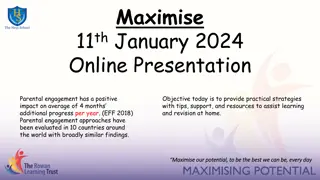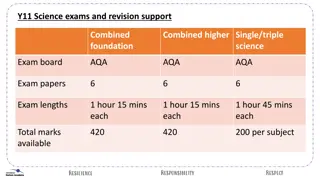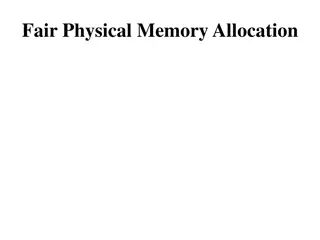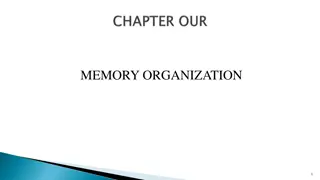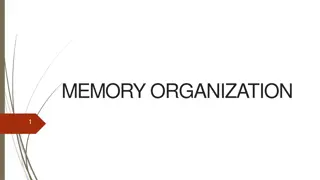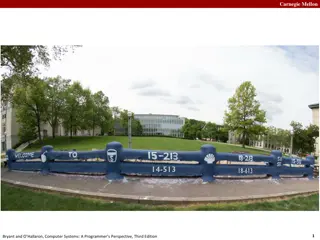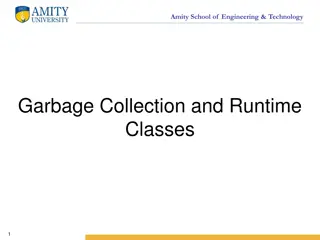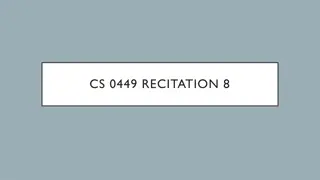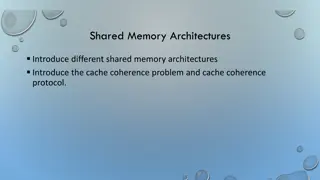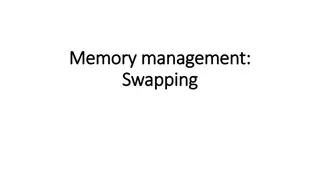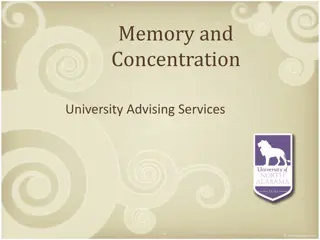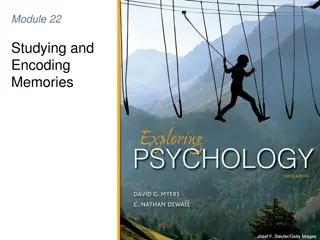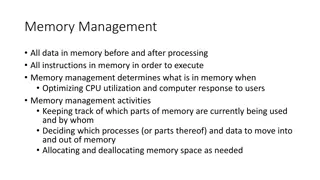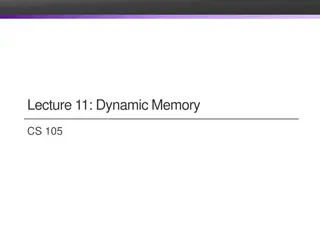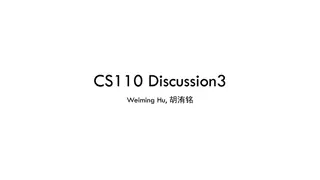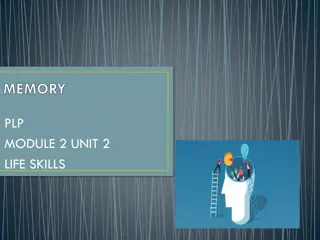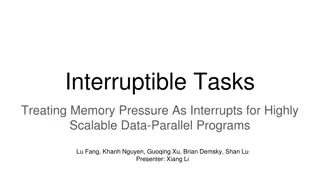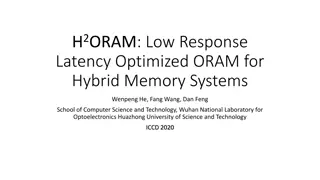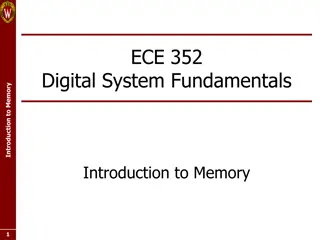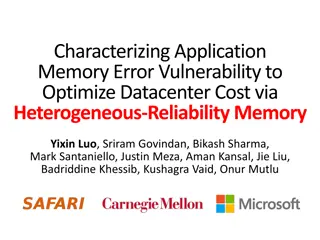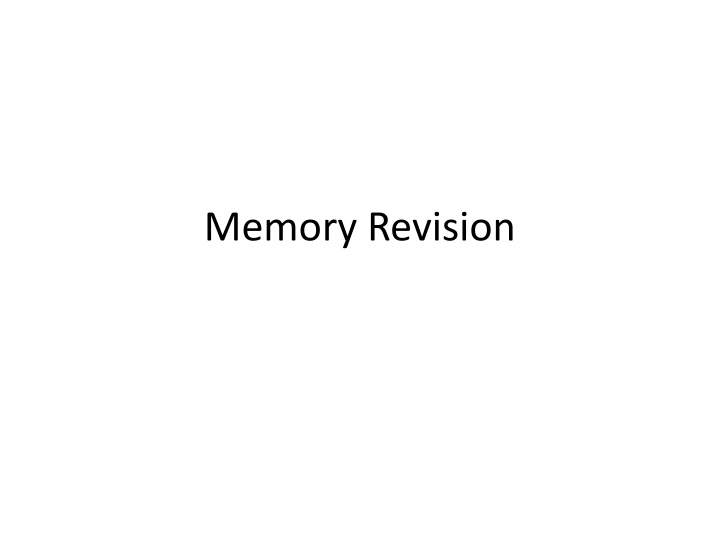
Understanding Memory: Models, Types, and Evaluation
Explore the intricacies of memory through discussions on memory coding, capacity, duration, and various models like the Multi-Store Model. Delve into types of long-term memory such as episodic, semantic, and procedural memory, with evaluations supported by studies and research.
Download Presentation

Please find below an Image/Link to download the presentation.
The content on the website is provided AS IS for your information and personal use only. It may not be sold, licensed, or shared on other websites without obtaining consent from the author. If you encounter any issues during the download, it is possible that the publisher has removed the file from their server.
You are allowed to download the files provided on this website for personal or commercial use, subject to the condition that they are used lawfully. All files are the property of their respective owners.
The content on the website is provided AS IS for your information and personal use only. It may not be sold, licensed, or shared on other websites without obtaining consent from the author.
E N D
Presentation Transcript
Rate your confidence on Memory Coding, Capacity and Duration of Memory The Multi-Store Model of Memory Types of Long-Term Memory The Working Memory Model Explanations of Forgetting: Interference Explanations of Forgetting: Retrieval Failure EWT: Misleading Information EWT: Anxiety EWT: The Cognitive Interview
Coding, Capacity and Duration of Memory Capacity Duration Coding Duration is the measure of how long memory lasts before it is no longer available. Capacity is the measure of how much can be held in memory. Coding is the way information is changed so it can be stored in memory. Peterson and Peterson (1959) Students recalled about 80% of the syllables correctly. Average recall after 18 seconds fell to 3% Jacobs (1887) Digit Span: participants could repeat back 9.3 numbers and 7.3 letters. Baddeley (1966) Immediate recall is worse with acoustically dissimilar words. Recall after 20 minutes worse with semantically dissimilar words Bahrick et al (1975) Participants tested 48 years after graduation were 70% accurate in photo recognition Miller (1959) Span on STM is 7 2 but can be improved with chunking STM s capacity is 7 2 LTM s capacity is unlimited STM is coded acoustically. LTM is coded semantically. STM s duration is 18-30 seconds LTM s duration is unlimited EVALUATION: EVALUATION: EVALUATION: - Jacob s study is outdated - Miller s research may have overestimated STM - Baddeley sstudy didn t use meaningful material. - Peterson and Peterson s study is artificial + Bahrick s study had high external validity
The Multi-Store Model of Memory Sensory Register Long Term Memory Stimulus from the environment passes into SR along with other sights and sounds. This is 5 stores, one for each sense. A permanent memory store. Coding: Semantic Capacity: Potentially unlimited Duration: Potentially up to a lifetime Short Term Memory STM is a limited capacity and duration store. Coding: depends on the sense (e.g. visual) Capacity: High (over one hundred million cells in one eye alone) Duration: Very brief (less that 1 second) Retrieval Coding: Acoustic Capacity: Between 5 and 9 items Duration: 18-30 seconds In order to recall information we have to retrieve it from long term memory back to short term memory in order to say it. Maintenance Rehearsal EVALUATION: Attention We repeat material to ourselves. If we rehearse it long enough it passes into Long Term Memory. + Supported by research into coding, capacity and duration - Evidence has suggested short term memory is not just one store - Oversimpilifies short term memory - Research uses artificial tasks Attention needs to be paid to the sensory information for it to pass into STM
Types of Long-Term Memory Episodic Memory Semantic Memory Procedural Memory Stores episodes from our life. They are time-stamped. You have to make a conscious effort to recall them. Stores our knowledge of the world. These memories are less personal. Stores memories for actions and skills. Recall occurs without awareness or effort. E.G What a car is and how it works E.G How to drive a car E.G The first time you drove a car EVALUATION: + Support from the case study of Clive Wearing who had difficulty recalling events that happened to him but his semantic memories were unaffected. + Brain scan studies have shown that there are different stores for LTM + Identifying different LTM stores has real-life applications. Psychologists can target certain kinds of memory in order to improve their lives. - Problems with clinical evidence. Lack of control when dealing with people with brain damage - Tulving has suggested that there may only be 2 types of LTM.
The Working Memory Model Phonological Loop Central Executive: Deals with auditory information and preserves the order in which the information arrives. It is subdivided into: Phonological Store: stores the words you hear Articulatory Process: allows maintenance rehearsal (repeating sounds to keep them in WMM) Monitors incoming data and allocates slave systems to tasks. Coding: Flexible Capacity: Very Limited Episodic Buffer: Visuo-Spatial Sketchpad It s a temporary store for information. Integrates visual, spatial and verbal information from other stores. It maintains sense of time sequencing so records events that are happening Stores visual and spatial information when required. Logie subdivided in into: Visual Cache: Stores visual data Inner Scribe: Records arrangement of objects in visual field Coding: Acoustic Capacity: 2 seconds EVALUATION + Dual task performance studies support the VSS + Word length effect supports the PL + Support from brain scanning studies - Lacks clarity over the central executive Coding: Flexible Capacity: 4 chunks Coding: Visual and Spatial Capacity: 3-4 objects
EWT: Misleading Information Leading Questions: Post-Event Discussion Response-Bias Explanation: Wording of a question has no enduring effect on an eyewitness s memory of an event, but influences the kind of answer given Memory Contamination: When co-witnesses discuss a crime, the mix (mis)information from other witnesses with their own memories. Memory Conformity: Witnesses go along with each other to win social approval or because they believe the other witnesses are right Substitution Explanation: Wording of a question does affect eyewitness memory; it interferes with its original memory, distorting its accuracy. Gabbert et al (2003) Participants watched a video of the same crime but filmed from different angles. 71% mistakenly recalled aspects that they did not see in the video but had picked up in post- event discussion Loftus and Palmer (1974) 5 groups of participants, each given a different verb in the critical question: hit, contacted, bumped, collided or smashed. The verb contacted produced a mean estimated speed of 31.8 mph, the verb smashed, the mean was 40.5mph The leading question biased eyewitness recall of an event. EVALUATION + Research has real-life application - Loftus and Palmer s study used artificial materials - There could be individual differences in accuracy of EWT. - Lab studies suffer from demand characteristics - EWT studies lack external validity
EWT: Anxiety Anxiety had a Negative Effect Anxiety had a Positive Effect Johnson and Scott (1976) 49% of participants in the low-anxiety condition were able to identify the man in the line up. High anxiety condition participants was 33% Yuille and Cutshall (1986) Witnesses were very accurate and there was little change after 5 months. The Tunnel theory of memory argues that a witness s attention is on the weapon (Weapon Focus), because it is a source of danger and anxiety. EVALUATION: - Johnson and Scott s study is that is may test surprise not anxiety - Field studies lack control of variables - Some ethical issues involved in researching anxiety - Yerkes-Dodson Law is limited as it s too simplistic - Demand characteristics may have arose in the studies Explaining Contradictory Findings Inverted U Theory: Yerkes and Dodson (1908) argue that extremely high levels of anxiety would produce low recall and extremely low levels of anxiety will produce low recall but medium levels of anxiety produce high levels of recall.
Revision Focus today: Forgetting Cognitive interview
Forgetting: Interference Theory Forgetting occurs in Long Term Memory because we can t get access to memories even though they are available. McGeoch and McDonald (1931) Participants were asked to learn a list of words to 100% accuracy. Performance depended on the nature of the second list of words. The most similar material (synonyms) produced the worst recall. When the participants were given very different material, such as three-digit numbers, the mean number of items recalled increased. Proactive Interference: occurs when an older memory disrupts a newer one Retroactive Interference: occurs when a newer memory disrupts an older one Interference is strongest when the memories are similar Interference is worse when memories are similar. This can be because in proactive interference previously stored information makes new information more difficult to store or in retroactive interference new information overwrites previous memories which are similar. EVALUATION: + Evidence from lab studies consistently demonstrated interference in memory + Real-life studies have supported the interference explanation - Research includes artificial materials - Interference effects may be overcome by using cues
Exam Questions Aaron was upset as he left the Spanish exam. In the unfamiliar room and full of nerves, his mind had gone completely blank. He was regretting studying both French and Spanish because he was sure he had mixed up lots of the words. (a) Outline the explanation of interference in forgetting. How might this explanation account for Aaron s poor performance in the Spanish exam?
Answers Interference when two memories conflict / confuse / become mixed up with each other more likely when material is similar (creates response competition) proactive interference when an older memory disrupts a newer memory retroactive interference when a newer memory disrupts an older memory Possible applications: Aaron has mixed up / confused words from another subject which has caused him to forget interference is likely in this case because French and Spanish are similar
Exam Questions Aaron was upset as he left the Spanish exam. In the unfamiliar room and full of nerves, his mind had gone completely blank. He was regretting studying both French and Spanish because he was sure he had mixed up lots of the words. (b) Discuss the explanation of forgetting you have outlined in your answer to part (a). (6 marks)
Answers Possible evaluation points: use of evidence from lab studies, e.g. McGeoch and McDonald application of explanation, e.g. avoiding similar material when revising for exams use of artificial materials in lab studies, e.g. recall of word lists deliberate attempt to induce interference in lab studies, e.g. by limiting time between learning and recall lacks ecological validity.
Forgetting: Retrieval Failure State-Dependent Forgetting When information is initially placed in memory, associated cues are stored at the same time. If these are not available at the time of recall, you may not be able to access memories that are actually there. When memory retrieval is dependent on an internal cue, state of mind Carter and Cassidy: Hayfever Medication When the internal state didn t match (learnt on the drug, recalled off the drug) recall was significantly worse than when they did match (learnt on the drug, recalled on the drug) Encoding Specificity Principle Tulving suggests that cues help retrieval if the same cues are present at encoding and at retrieval. The closer the retrieval cue to the original cue, the better it works. Context-Dependent Forgetting EVALUATION: When memory retrieval is dependent on an external/environmental cue. + Lots of evidence that supports the explanation of forgetting + Context-related cues have useful everyday applications - Evidence to show that context effects are not very strong in real-life - ESP cannot be tested - Contextual effects only occur when memory is tested in certain ways Godden and Baddeley (1975): Deep-Sea Divers When the environmental cues did not match (learn on land, recalled underwater) recall was 40% lower than when they did match (e.g learn underwater, recalled underwater)
Exam Questions Toby and Sarah both studied AS Psychology at the same school. Toby s class was taught in the school lecture theatre while Sarah s class had their lessons in a science classroom. Both students sat their final psychology exam in the school lecture theatre. Which student is likely to perform worse in their final psychology exam? Use your knowledge of explanations of forgetting to justify your answer. (4 marks)
Answers 1 mark for identifying Sarah 3 marks for a thorough explanation with supporting evidence: 1. Sarah learnt and recalled in a different environment / context the cues present when learning the psychology material in the classroom would not have been present at recall in the lecture theatre for Sarah reference to the encoding specificity principle 2. the absence of the cues meant that Sarah did not have any triggers to aid her recall and this caused retrieval failure 3. using research evidence to support the explanation of why Sarah s performance is likely to be worse, e.g. Godden & Baddeley (1975) or Abernethy (1940)
EWT: The Cognitive Interview Report Everything Change Perspective Witnesses are encourages to include every detail of an event, even if it seems irrelevant or the witness is not confident about it. Seemingly trivial details could be important and may trigger other memories. Witnesses recall the incident from other people s perspectives. How would it have appeared to another witness or the perpetrator? This prevents the influence of expectations and schema on recall. Reinstate the Context Reverse the Order The witness returns to the original crime scene in their mind and imagines the environment and their emotions. This is based on the concept of context-dependent forgetting. Cues from the context may trigger recall. Events are recalled in a different chronological order. This prevents people using their expectations of how the event must have happened rather than the actual events. It also prevents dishonesty. EVALUATION + Research suggests that some elements are very useful + Support for the effectiveness of the enhanced CI - Time consuming - Research may be unreliable because of variations of the CI - Produces an increase in inaccurate information The Enhanced Cognitive Interview Fisher et al (1987) developed additional elements of the CI. It includes a focus on the social dynamics of the interaction. It also includes such as reducing the eyewitness s anxiety, minimising distractions, getting the witness to speak slowly, and asking open-ended questions.
Exam Questions Outline techniques used in the cognitive interview and discuss the effectiveness of these techniques on the accuracy of eyewitness testimony. (8 marks)
Answers Possible discussion points: how / why recall is enhanced, e.g. role of context reinstatement; work on reconstructive memory; use of context; makes the event more meaningful limitations, e.g. usefulness of the cognitive interview with children; less useful when there is increased time between event and recall relative effectiveness of individual features of the cognitive interview; better for recall of peripheral detail than central detail use of relevant evidence to support / refute argument, e.g. Kohnken et al (1999); Milne & Bull (2002).
Exam Questions Traditionally, police have questioned eye witnesses using the standard interview procedure. This involves a period of free recall about an event, followed by specific questions. However, an increasing number of police forces are now using the cognitive interview technique. Explain how a cognitive interview differs from a standard interview. (4 marks)
Answers Differences could include effectiveness of cognitive interviews and implications such as cost of training required, time it takes, etc. The main techniques used in a cognitive interview include context reinstatement (CR), reporting everything (RE), recall from a changed perspective (CP) recall in reverse order. Candidates who show some understanding of a cognitive interview, e.g. by naming / outlining one or more of the techniques above, but make no attempt to explain a difference should be awarded a maximum of 2 marks. Further marks for elaboration, e.g. a standard interview might just ask witnesses to recall an event, but a cognitive interview could ask them to recall the context in which the event occurred. This could include environmental details (such as the weather) and emotional factors (such as how they felt at the time).

